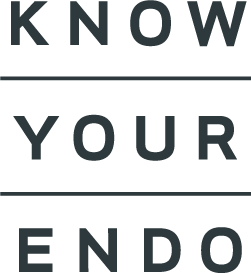This is a pretty powerful statistic,
but we understand it isn't 100% inclusive. And inclusion matters to us.
Our website is intended to be a resource for everyone living with endometriosis.
That includes girls as well as trans, non-binary, and gender non-conforming people.
What is endometriosis?
Endometriosis is a disorder where the tissue similar to the tissue that lines the inside of the uterus grows on the outside. It usually involves the ovaries, bowel, or the tissue lining your pelvis, though sometimes it can spread beyond the pelvic region. During your menstrual cycle, this displaced tissue thickens, breaks down, and bleeds. Because this tissue has no way to exit the body, it becomes trapped. This can lead to cyst formation, adhesions, and pain.
Who can get endometriosis?
Anyone in their reproductive years.
Short, tall, black, white...it does not discriminate.
How is it diagnosed?
Diagnosing endometriosis requires a surgical biopsy, typically involving an outpatient procedure called laparoscopy.
What are the symptoms?
It takes an average of 10 years and 8 doctors to be diagnosed with endometriosis.
It's often misdiagnosed as appendicitis, colon and ovarian cancer, fibroids, irritable bowel syndrome (IBS), and/or sexually transmitted diseases. That's why it's critical for women to know, understand, and be vocal about their symptoms. Education and awareness can lead to early detection.
Symptoms:
Very painful periods (pelvic pain, cramping, lower back and abdominal pain)*
Pain during ovulation or two weeks after your period
Leg pain or neuralgia (nerve sensations) associated with your cycle
Hip pain and/or back pain
Shoulder/chest pain or shortness of breath with your cycle
Pain during or after sex
Thick blood clots (often dark) with your period
Painful bowel movements or painful urination
Excessive bleeding
Fatigue and chronic pain
Diarrhea and constipation
Bloating
Nausea and vomiting
Urinary frequency, retention, or urgency
Allergies and other immune-related issues
Infertility and pregnancy loss (though many people can still have children)
*Not everyone with endometriosis has painful periods. Some people experience periods without pain but then experience other symptoms the rest of the month.
How do I know if my periods are "painful?"
Do you miss school or work because of your periods? Are there days where nothing helps the pain (even Aleve, Advil, etc)? Do you plan your life around your period or just "push through" the pain? These would be considered signs of abnormally painful periods.
I don't have painful periods, so I probably
don't have endo, right?
A woman with endometriosis might experience one or all of the symptoms. It doesn’t matter the number - one symptom might be all it takes to disrupt your everyday life and activities.
How do you treat and manage?
Treat:
Laparoscopic surgery
*Excision surgery is the gold standard for treatment.
Learn more about the different kinds of surgeries in the Ask A Doctor section.
Traditional Management:*
Hormone treatment
Painkillers
The pill
*These treatments can cause negative side effects in some people. Do your research and find a doctor that is open to discussing holistic wellness practices & diet and lifestyle tools, in addition to hormones and drugs.
Lifestyle Management Tools:*
Diet and nutrition
Massage
Exercise
Stress-management hobbies + activities
Therapy
Chinese Medicine (acupuncture + herbs)
CBD/Cannabis
*These tools will work in different ways for every person. They will not stop your endo from growing but can potentially help manage the pain and symptoms. Learn more about these.


